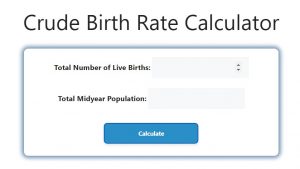About Crude Birth Rate Calculator (Formula)
The Crude Birth Rate (CBR) is a vital demographic measure that indicates the number of live births in a population over a specific period, usually a year. It is expressed per 1,000 individuals in the population. Understanding the CBR is crucial for various fields, including public health, sociology, and economics, as it helps analyze population growth, reproductive health, and social planning. This article will explain how to use the Crude Birth Rate Calculator, provide a detailed example, and address common questions related to the CBR.
Formula
The formula for calculating the Crude Birth Rate (CBR) is:
Crude Birth Rate (CBR) = (Number of Live Births / Population) * 1,000
How to Use
Using the Crude Birth Rate Calculator is straightforward. Follow these steps:
- Determine the Number of Live Births: Gather the data for the total number of live births that occurred in the population during the specified time frame (typically one year).
- Find the Total Population: Obtain the total population figure for the same time frame. This data is often available from national statistics agencies or demographic studies.
- Input the Values: Enter the values for the number of live births and the total population into the calculator.
- Calculate the Crude Birth Rate: The calculator will compute the Crude Birth Rate by applying the formula, giving you the rate of live births per 1,000 people in the population.
Example
Suppose a town has a population of 50,000 people and recorded 750 live births in a year. To calculate the Crude Birth Rate (CBR), we use the formula:
Crude Birth Rate (CBR) = (Number of Live Births / Population) * 1,000
In this case:
Crude Birth Rate (CBR) = (750 / 50,000) * 1,000
CBR = 0.015 * 1,000
CBR = 15
Thus, the Crude Birth Rate for this town is 15 live births per 1,000 people.

FAQs
1. What is the Crude Birth Rate (CBR)?
The Crude Birth Rate is a demographic measure that represents the number of live births per 1,000 people in a population over a specific time period, typically one year.
2. Why is the Crude Birth Rate important?
CBR is essential for understanding population growth, planning resources, and developing public health policies.
3. How is the Crude Birth Rate different from the General Fertility Rate?
The CBR measures live births in relation to the total population, while the General Fertility Rate measures live births relative to the number of women of childbearing age.
4. How can I find the number of live births in my area?
You can obtain this data from local health departments, census bureaus, or demographic surveys.
5. Is the Crude Birth Rate the same worldwide?
No, CBR varies significantly across different regions and countries due to factors like culture, healthcare access, and socioeconomic status.
6. What factors can influence the Crude Birth Rate?
Factors include economic conditions, education levels, healthcare access, cultural norms, and government policies on family planning.
7. Can CBR be used to predict future population growth?
While CBR provides insights into current birth rates, it should be used alongside other demographic indicators for more accurate population projections.
8. What is a high Crude Birth Rate?
CBR values over 30 live births per 1,000 people are generally considered high, while values below 10 are considered low.
9. How does a declining Crude Birth Rate affect a country?
A declining CBR can lead to an aging population and potential labor shortages, impacting economic growth and social services.
10. Can the Crude Birth Rate vary by age group?
Yes, age-specific birth rates can be calculated to analyze the birth rates among different age groups, particularly women of reproductive age.
11. How often is the Crude Birth Rate calculated?
CBR is typically calculated annually, but it can be assessed more frequently in specific studies or surveys.
12. What is the relationship between CBR and mortality rates?
A higher CBR can offset higher mortality rates in a population, influencing overall population stability.
13. How does urbanization affect the Crude Birth Rate?
Urban areas often exhibit lower CBRs compared to rural areas due to factors like access to education and family planning resources.
14. Can cultural practices impact the Crude Birth Rate?
Yes, cultural beliefs and practices regarding family size and childbearing can significantly influence the CBR.
15. How is the Crude Birth Rate used in public health?
Public health officials use CBR to assess reproductive health needs and to plan maternal and child health services.
16. What data is required to calculate the Crude Birth Rate?
You need the total number of live births and the total population figure for the same time frame.
17. Is the Crude Birth Rate a reliable indicator of population health?
While CBR provides valuable insights, it should be analyzed alongside other health indicators for a comprehensive understanding.
18. How do government policies influence the Crude Birth Rate?
Policies promoting family planning, reproductive health education, and financial incentives can all impact birth rates.
19. Can changes in the economy affect the Crude Birth Rate?
Yes, economic conditions can influence family planning decisions and access to healthcare, thus affecting the CBR.
20. What are the limitations of using CBR for demographic studies?
CBR does not account for the age structure of the population, which can be crucial for understanding fertility patterns and demographic changes.
Conclusion
The Crude Birth Rate Calculator is a valuable tool for analyzing birth trends within a population. By understanding how to use this calculator and the significance of the CBR, individuals, researchers, and policymakers can make informed decisions based on demographic data. The insights gained from calculating the Crude Birth Rate can contribute to effective resource allocation, health planning, and societal development.
